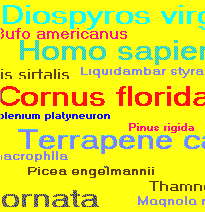
Names are "handles" your mind can take hold of, in order to find out what's interesting about the natural things you see. You can't grasp how truly mind boggling Nature's diversity and ways of being are until names have revealed many secrets of the natural things you've encountered.
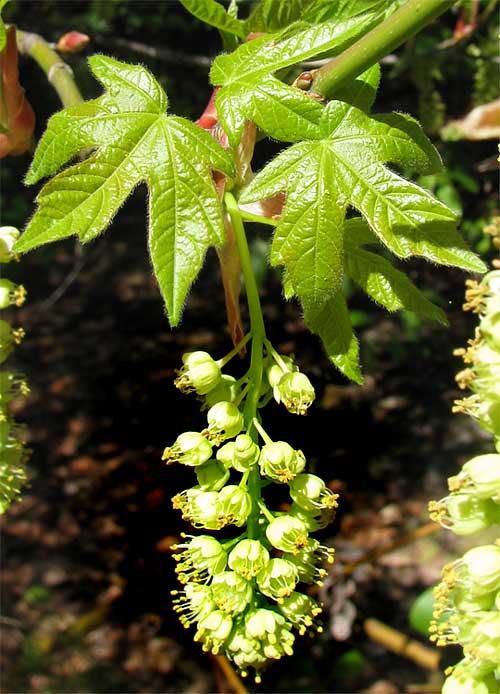
Classification reveals how all living things are related to one another. If you find a tree species you've never seen before, but you can recognize it as a kind of maple, like the one shown at the right, and you already know the basic features of maples, automatically you know a lot about your newly encountered tree. For instance, its fruit, composed of two winged parts, later will break apart, with each part containing one seed.
Once you can visualize how "mapleness" is one stream of evolution and "oakness" is another, and that there are thousands of such streams, and millions of streamlets, in the natural evolutionary flow all around you... you'll get a soul-pleasing buzz, and a deep feeling for what the river of evolution is all about.
A WORM PUZZLE
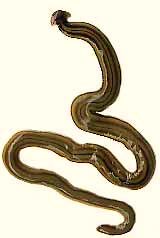
Let's say a friend brings you the curious-looking critter seen at the left. It'd been found crossing a wet sidewalk in southern Mississippi. "What is it?" the friend asks. You can see that the creature bears no legs, so it's not an arthropod such as a centipede or millipede, and it's not segmented, so it isn't an annelid like an earthworm. Its brownish flesh looks soft and rubbery like that of a mollusk such as a snail, but it is flatish and bears no antennae.
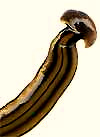
While you're going through this thinking process, the organism raises its head spread out like a cobra's, the way you see at the right. Then you know what it was. It's a planarian, something you'd seen in biology class, then more or less forgot all about.
The important thing here is that even before it had revealed its identity, the creature's identity was narrowed down considerably by rejecting all the living world's major "phyla" that it couldn't be. "No legs," so not an arthropod. "Not segmented," so not an annelid. Planarians belong to the Flatworm Phylum.
Once the phylum is recognized, it's easy enough to do an image search on planarians found in southern Mississippi, which quickly turns up an identified picture of our discovery. It's Bipalium kewense, sometimes known as the Hammerhead Flatworm.
 Bipalium kewense eating earthworm; image courtesy of Jean-Lou Justine, Leigh Winsor, Delphine Gey, Pierre Gros, and Jessica Thévenot
Bipalium kewense eating earthworm; image courtesy of Jean-Lou Justine, Leigh Winsor, Delphine Gey, Pierre Gros, and Jessica ThévenotLooking up that name, quickly you and your friend learn that the species is native to Southeast Asia, but now found worldwide, probably introduced elsewhere through imported plants. It eats earthworms by extending its pharynx -- the part of the throat behind the mouth -- outside of its body and onto the earthworm, thus starting the digestion process before taking the earthworm into its body. This explains how it's possible for the flatworm to use just one hole in its body as both mouth and anus. Moreover, the planarian nervous system is arranged in such a way that when it grows long enough, its rear end holds onto the ground, a narrowing develops somewhere in its lower half, and the front end simply pulls away from the back, leaving the back part parked. Then the back part grows a new head and a new planarian is formed!
A BIRDING TRIP TO SOUTH AFRICA
Besides being keys to a whole world of fascinating information, names also can help you put your findings into perspective. Here's an example:
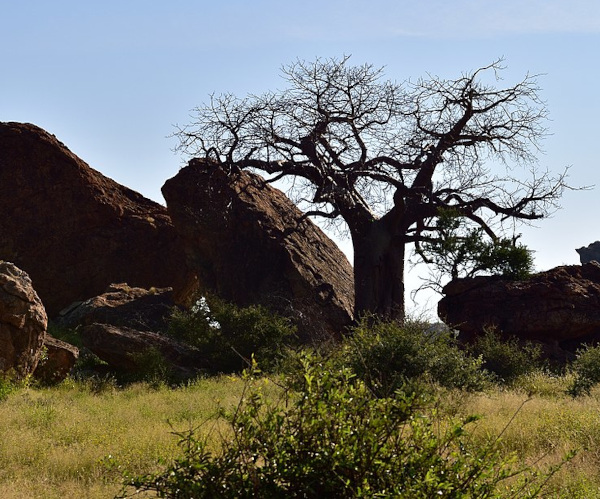 South African landscape; image courtesy of South African Tourism and Wikimedia Commons
South African landscape; image courtesy of South African Tourism and Wikimedia CommonsLet's say that one day you're able to visit, say, South Africa, and you've become very interested in birds. You pack your binoculars and a notebook, fly to Johannesburg, buy a field guide to South African birds, take a bus into the hinterland, and bright and early one morning begin listing every bird you can identify.
As you begin listing, you may be surprised that you already recognize a few species, for South Africa's towns are full of House Sparrows and European Starlings, now found nearly worldwide, plus, out in the country there are other species North Americans and Europeans know, such as Barn Owls and Pintail ducks. The vast majority of South Africa's birds, however, are new to you.
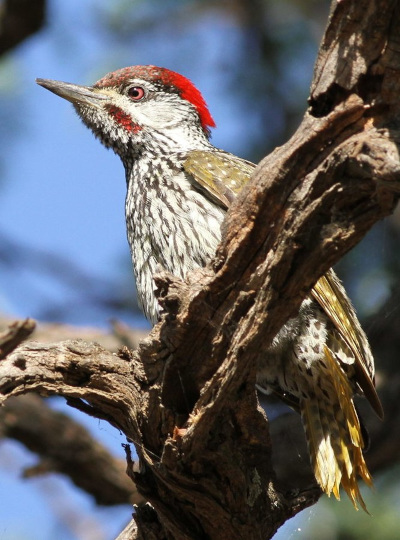 Golden-tailed Woodpecker, Campethera abingoni, in South Africa; image courtesy of Derek Keats & Wikimedia&Commons
Golden-tailed Woodpecker, Campethera abingoni, in South Africa; image courtesy of Derek Keats & Wikimedia&CommonsSome of these new bird species will strike you as being familiar, even though you're sure you've never seen those particular species before. You'll see, for example, birds that you know beyond all doubt belong to the woodpecker family (chisel-like beaks, stiff tail feathers, feet with two toes forward and two facing behind), but they will belong to entirely different genera, like the Golden-tailed Woodpecker at the left.
Maybe you'll see South Africa's Olive Thrush or Groundscraper Thrush, which will remind you in many ways of the American Robin. In fact, not only do these African species belong in the same family as American Robins, they are members of the same genus. They are just different species.
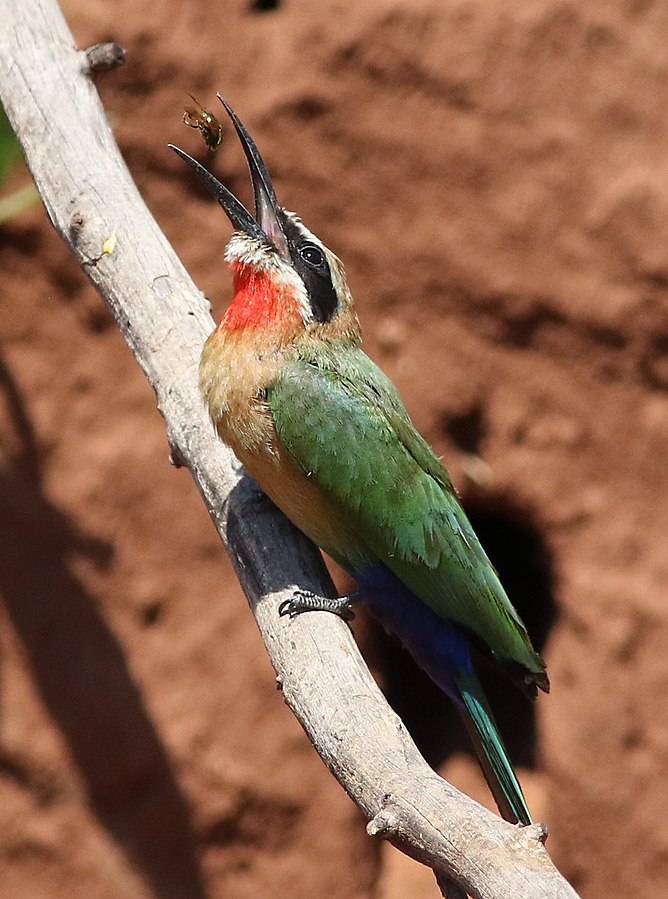 White-fronted Bee-eater, Merops bullockoides, in South Africa; image courtesy of Derek Keats & Wikimedia&Commons
White-fronted Bee-eater, Merops bullockoides, in South Africa; image courtesy of Derek Keats & Wikimedia&CommonsAnd then there will be species that simply throw you for a loop. You'll surely see bee-eaters, rainbow colored as shown at the right. Your field guide tells you that bee-eaters are in the same order as kingfishers, though in a family not occurring in North America. Kingfishers? Well, after you watch your bee-eaters awhile, you see that their flight is a little stiff and direct like the kingfishers', their calls are loud and simple like kingfishers', plus kingfishers can have some pretty colors, too, and their beaks certainly look kingfisher-like...
Finally, if you visit the right spots in South Africa, you'll see Ostriches and Jackass Penguins, representing two orders not represented by even a single species in North America. Adding whole new orders to one's Life List is a very big event in any birder's life.
A big event, that is, if you know what a bird order is. It's the same with the concepts of family, genus, and species. If you don't understand about orders, families, genera and species, you'll know that you're seeing new birds, and that some are somehow familiar while others are "exotic" to you, but you won't know how exotic they are, or even why.
Of course, these reasons for dealing with names and classification are as valid in your own backyard as in any foreign country. If you've gravitated to butterflies, for instance, and your Life List now includes sightings in all the major families -- the swallowtails, the milkweed butterflies, the brush-footed butterflies, etc. -- and then one fine day suddenly you spot a Yucca Giant Skipper of the Giant Skipper Family, and you've never seen any of the giant skippers, what a blast!
But, it'll only be a blast if you know the name of what you've seen, and if you know exactly how this species fits in with everything else -- its classification.
Finally, if you are ever to speak convincingly about why biological diversity is important on our planet and in your own neighborhood, names and classification will be very important tools for you. You can be a more effective eco-warrior when you can handle names and classification.
If you succeed in naming some things in your own neighborhood, be sure to consider posting your IDs at the wonderful iNaturalist.Org website.